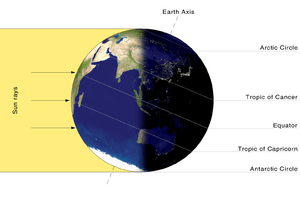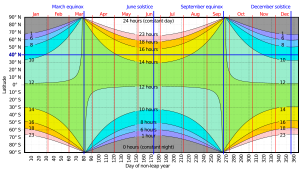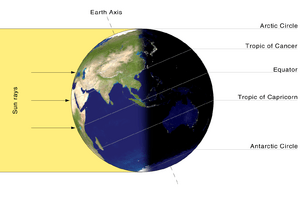Daytime facts for kids

Daytime is when your part of Earth gets natural light from the Sun. It happens when the Sun is visible above the local horizon. This means that anywhere on the half of Earth facing the Sun experiences daytime. You can see the Sun's movement during the day by watching the shadow cast by a sundial. Other planets and natural satellites also have daytime when they face their stars, but this article mainly talks about daytime on Earth.
Contents
What is Daytime Like?
About half of our planet is always lit up by the Sun. The area that gets direct sunlight is almost exactly half of Earth. However, because of Earth's atmosphere, light spreads out. This means a little more than half of the planet actually gets some light, whether it's direct or indirect sunshine.
How Earth's Spin Affects Day and Night
As Earth spins on its axis, the part of the planet experiencing daytime changes all the time. Earth's axis is tilted, not straight up and down compared to its path around the Sun. This tilt is why the length of daytime changes depending on where you are on the planet. It also causes the different seasons we experience.
Sunrise, Sunset, and Twilight
For someone on Earth, daytime usually starts at sunrise and ends at sunset. Sunrise is when the Sun's disc first appears above the horizon as Earth spins towards the east. Sunset is when the Sun's disc disappears below the horizon in the west.
Since the Sun looks like a disc and not just a tiny point of light, sunrise and sunset don't happen instantly. Earth's atmosphere also bends and scatters sunlight. This makes the periods of sunrise and sunset last longer. After sunset and before sunrise, the sky still gets some indirect light from the Sun. This period is called twilight. Some scientists, like astronomers, consider daytime to truly end only when the Sun is well below the horizon. This is because of the lingering indirect light.
Why Does Day Length Change?

The length of daytime is how long the period of daylight lasts. Earth's axis is tilted by about 23.44 degrees compared to its orbit around the Sun. This tilt causes the length of daytime to change with the seasons, depending on your latitude (how far north or south you are).
Areas that are tilted towards the Sun experience summer. Being tilted towards the Sun means they get more than half a day of daylight. They also have warmer temperatures because the Sun's rays hit them more directly. While more daylight can make it warmer, the main reason for summer heat is the directness of the Sun's rays. For example, the tropics are warm because the Sun is often high in the sky. The polar regions are cold because the Sun is always low.
Even though increased daylight has some effect, the directness of the Sun is more important for temperature. The poles are still cold in their summers, even with 24 hours of daylight for months. The Equator stays warm all year, even though it only gets about 12 hours of daylight each day.
Away from the Equator, daytime is shorter than 12 hours in winter and longer than 12 hours in summer. When it's winter in the Northern Hemisphere, it's summer in the Southern Hemisphere, and vice versa.
Daytime at the Equator
At the Equator, the daytime period is always about 12 hours long, no matter the season. From the Equator, the Sun always rises and sets almost straight up and down. Because of Earth's tilt, the Sun is always within 23.44 degrees north or south of the celestial equator. This means the point where the Sun is directly overhead (the subsolar point) is always within the tropics.
From March to September, the Sun rises and sets slightly north of due east and west. From September to March, it rises and sets slightly south of due east and west. On the equinoxes (around March 20th and September 22nd), the Sun is directly overhead at noon at the Equator.
The fact that the Sun is always so close to being directly overhead at the Equator explains why tropical areas are the warmest on Earth. Also, sunrise and sunset are shortest at the Equator. On the equinoxes, it only takes about two minutes for the Sun's disc to cross the horizon.
Daytime in the Tropics
The tropics are the areas on Earth between 23.44 degrees north and 23.44 degrees south of the Equator. In this zone, the Sun will be directly overhead at least once a year. The line at 23.44 degrees north is called the Tropic of Cancer. The line at 23.44 degrees south is called the Tropic of Capricorn.
On the Tropical Circles (the Tropic of Cancer and Tropic of Capricorn), the Sun is directly overhead only once a year, on the solstice for that hemisphere. Closer to the Equator, the Sun is directly overhead twice a year. This event is sometimes called a "zero shadow day" because objects don't cast a shadow at noon. Outside the tropics, the Sun is never directly overhead.
Daytime Near the Poles
Around the poles, the changes in daytime length are very extreme. Within 23.44 degrees of the poles, there are days each year when the Sun never goes below the horizon. This is known as the midnight sun. There are also days when the Sun never rises above the horizon, leading to long periods of darkness.
The Arctic Circle (66.56 degrees north latitude) and the Antarctic Circle (66.56 degrees south latitude) mark these boundaries. Beyond these circles, you can experience days with 24 hours of sunlight or 24 hours of darkness. However, for true 24-hour nights where stars are always visible, you need to be beyond about 73 degrees north or south latitude. This is because the sky can still be bright when the Sun is just below the horizon.
Even in summer, the Sun never gets very high above the horizon near the poles. This is one reason why these regions are always cold. Snow and ice also reflect a lot of sunlight, keeping them cold. At the summer solstice, the Sun is only about 23.44 degrees above the horizon at the poles. The Sun's path across the sky at the poles is like a circle, staying roughly the same height above the horizon for the whole day. This circle slowly sinks below the horizon as winter approaches and rises as summer approaches. At the poles, sunrise and sunset can take several days!
Daytime at Middle Latitudes
At middle latitudes, which are far from both the Equator and the poles, the changes in daytime length are moderate. In places like Montreal, Paris, or Ushuaia, the difference between summer and winter day length is very noticeable. In summer, the sky might still be light at 10 PM, but in winter, it could be dark by 5 PM.
Closer to the Equator in the middle latitudes, like southern California or Egypt, the seasonal difference is smaller. Still, there can be about a 4-hour difference in daylight between the winter and summer solstices. The closer you get to the Equator, the less pronounced this difference becomes.
See also
 In Spanish: Día (contrapuesto a noche) para niños
In Spanish: Día (contrapuesto a noche) para niños
- Daylight saving time
- Solar eclipse
- Sunrise equation
- Sunshine duration




